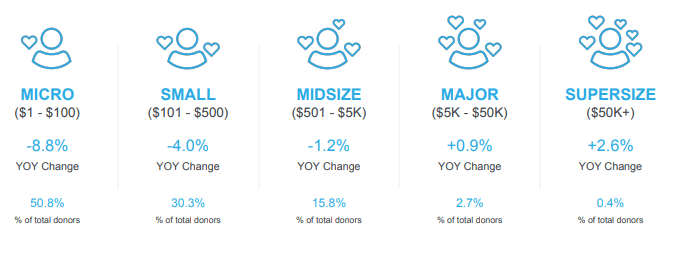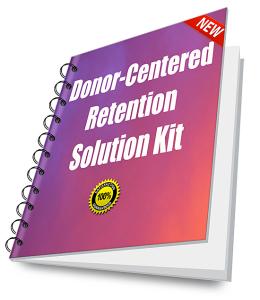 The results are in, and the news is generally bleak. The 2024 Fundraising Effectiveness Project Report* shows downward trends in numbers of donors (down 4.5%), and retention (down 2.6%).
The results are in, and the news is generally bleak. The 2024 Fundraising Effectiveness Project Report* shows downward trends in numbers of donors (down 4.5%), and retention (down 2.6%).
- First-time donor retention is at its lowest-ever recorded rate. Less than one in five new donors (acquired in 2023) gave again. New donors accounted for 40% of all givers.
- Overall retention (including ongoing donors) is just 42.9%. Just over two in ten renewed.
- Total numbers of donors decreased 4.5% — the fourth straight year donor numbers declined. This was primarily driven by the decrease in new donor engagement.
- Total dollars raised increased modestly, but when adjusted for inflation were down 2.4%.
As discouraging as these results are, this doesn’t mean you should give up hope.
To the contrary, now is the time to prioritize revving up your strategies to proactively engage with individual donors who can have the most transformative impact on your ability to fulfill your vision and enact your mission and values. With federal grant cutbacks looming, and foundations comprising only 19% of all giving, focusing on individuals — at all levels (who collectively give 75% of all philanthropy per Giving USA) – is the path forward towards sustainability.
And you’ve got plenty of tools at your disposal!
When Giving Falls, Hope Can’t—What Your Nonprofit Needs to Do Now
While the landscape may look bleak at first blush, Americans have a long philanthropic tradition. Per Erik Daubert, nonprofit management specialist at the Lilly Family School of Philanthropy at Indiana University, people are inclined towards generosity. Did you know only 12% of Americans never donate? It is your job as a philanthropy facilitator to reach out to people who want to make a difference, letting them know specifically how they can help.
1. Nurture major donors; they’ll have the largest impact.
The trend is a concentration of philanthropy into fewer, but higher-level, donors. This is the only reason total dollars raised last year increased 3.5% overall.
The growing role of individual major gift donors means all nonprofits, no matter their shape and size, should begin to rev up a major gift program.
- Donors giving more than $50,000 were up 2.6% last year.
- Donors giving $5,000 to $50,000 increased nearly 1%.
- Combined, these donors made up 3% of 2024’s total number of donors, but nearly 78% of total dollars given.
- Major donors were retained at a rate of more than two-thirds.
- Donors giving at any level below $5,000 decreased
 Fundraising Effectiveness Project 2024
Fundraising Effectiveness Project 2024
Major donor fundraising must be done strategically, with an eye to current realities.
The average age at which major donors make their first large gift has increased from 55 to 66 years over the past two decades. Older donors appreciate and respond well to face-to-face communication methods. They take their time to research causes they care about to ensure they make wise decisions about where to direct their philanthropic giving. Keep these preferences in mind as you build relationships with prospective major donors.
NOTE: Because these individual donors can provide as much as 80 – 95% of your contribution income, it makes sense to invest in good training for your staff. Don’t just wait by the phone for them to come to you. Here is one option I recommend.
2. Don’t ignore small dollar donors; they’re important too.
Smart nonprofits will rededicate efforts with smaller individual donors – without whom you’ll have no one to fuel your mid-level and major donor pipeline.
“Our Q4 FEP data emphasizes the growing reliance on fewer, larger gifts, a trend that underscores the urgency of revitalizing small donor engagement to sustain long-term sector health.”
— Woodrow Rosenbaum, chief data officer, GivingTuesday
Don’t just water the trees that will turn into giant oaks and redwoods. There’s a lot of value across the donor spectrum, but you’ll never reap the benefit if you don’t plant and tend the orchard. It’s your job to nurture small and mid-sized donors who can become increasingly loyal and generous over time.
While smaller donors may have less disposable income for immediate giving, it’s still wise to build relationships with folks who may be able to give more than you might guess. In fact, many own homes or other assets which have seen significant increases in value over the past 30 years. Some have been frugal all their lives and may not have children to whom to leave their wealth. To put it colloquially, “there’s gold in them thar hills!”
- Smaller dollar donors make up the lion’s share of planned giving at most organizations. This suggests a dynamic in which the most frugal donors are also lifelong savers well-positioned to give the largest bequests.
- Smaller donors today also have donor advised funds. They’ve put aside money specifically for philanthropy, and you want to be proactive leveraging gifts from their DAFs.
- Retention increases dramatically when you convert one-time givers to monthly supporters. Develop a written plan for recurring gifts, and you should be able to keep as many as 80-90% of your supporters – roughly doubling your retention rate from 42.9%. Your average gift size will also increase.
ACTION TIPS: Develop a written donor retention and gratitude plan to assure you don’t overlook the little seeds and buds that can blossom into major lifetime and/or legacy givers. Here are two easy things to do right away:
-
Convert more small dollar donors to monthly giving.
-
Explain how legacy giving helps you plan for the future. Wherever you can (e.g., remit piece; donation landing page; dedicated email or mailing; email signature block, etc.) regularly ask supporters: “Have you included us in your will or estate plan?” Also ask “What motivated you to do so?,” explaining how understanding this helps you motivate others to join them.
3. Pay attention to changing demographics; they’ll have an effect.
The current average age of repeat donors is 64, and the best practices nonprofits relied on to appeal to these Baby Boomers have not been as effective with Gen X, Millennials, and Gen Z. It’s critical for nonprofits moving forward to have a fundamental understanding of the values, beliefs, and motivations of the new generations they’ll be relying on.
While younger donors may today be small to mid-size givers, there is a $30-84 trillion wealth transfer set to change hands. Nurture these donors now to set yourself up for future success.
Rev Up Your Fundraising to Better Understand Donor Motivations and Needs
People give, largely, because it feels good. Part of your job as a philanthropy facilitator is to attempt to better understand donor motivations – across all giving segments. Endeavor to find out:
- Why donors give to you for the first time.
- Why donors give you a second gift.
- Why donors give monthly.
- What donors want from you in terms of ongoing engagement.
- What donors most appreciate when it comes to the gratitude, recognition and reporting they receive from you.
Listen, and learn.
A recent study by Bloomerang found retention grows when fundraisers focus on connection, consistency, and the purpose and meaning donors seek. Donors don’t just want to feel appreciated—they want to see their impact and feel like part of something bigger.
Want More Donor Retention Tips?
 Get my Donor Retention and Gratitude Playbook with 6 separate companion guides (purchase individually or at a bundle bargain discount). Taken together, they include everything you need to raise more money — by keeping more current donors and increasing their average gift! It’s filled with hands-on, practical information garnered from my 30+ years working in the nonprofit trenches. The Attitude of Gratitude Donor Guide alone is 98 full pages, with lots of ready-to-use samples and templates.
Get my Donor Retention and Gratitude Playbook with 6 separate companion guides (purchase individually or at a bundle bargain discount). Taken together, they include everything you need to raise more money — by keeping more current donors and increasing their average gift! It’s filled with hands-on, practical information garnered from my 30+ years working in the nonprofit trenches. The Attitude of Gratitude Donor Guide alone is 98 full pages, with lots of ready-to-use samples and templates.
*The “Fundraising Effectiveness Project (FEP) Quarterly Fundraising Report” from the Association of Fundraising Professionals Foundation for Philanthropy and GivingTuesday features 12 nonprofit tech vendors that provide aggregate data from more than 12,000 organizations that raised $10.5 billion from 6.7 million donors last year. The aggregate data is used in year-over-year comparisons to evaluate the state of fundraising.
Photo by alaa turkman on Unsplash






This is a fantastic Roundup, thank you for sharing the work of the Fundraising Effectiveness Project!
Thanks Tim. It’s an amazing endeavor, a true gift to the sector. Now, if we could only commit to using what we learn to improve donor retention and build lasting relationships to sustain our missions.